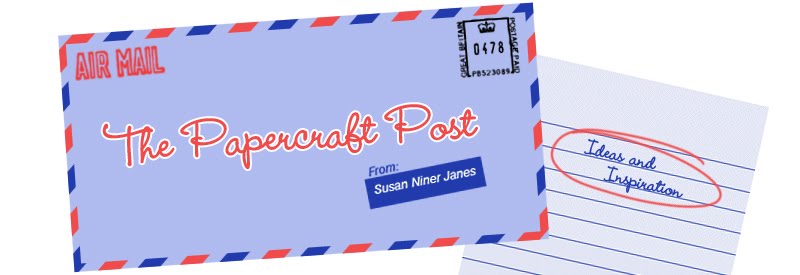 | ||
| Basic caddy: bird's-eye view (top); straight-on (bottom). |
 |
| Three styles: basic (left), double-ribbon card (right), single ribbon card (front). |
 | |
| Double-ribbon card style with lidded boxes. |
These thread caddies are papercraft interpretations of traditional sewing aides called quilter's dollies. The cotton reels are loaded into the pockets and a ribbon is threaded through them. The cotton reels can then rotate freely as you unwind the thread - very handy. The centre of the caddy can hold pins, needles, thimble. For optimum use of the space on the handle, I have designed some of the caddies as ribbon cards.
The caddies make wonderful gifts for sewing enthusiasts. The caddy doubles as a useful gift on its own and as attractive gift packaging.
Here's how to make the caddies:
1) Cut out the pieces (pattern templates to follow). You need a centre box, four thread pockets, and a handle for the basic caddy. Score and fold as indicated, using an embossing tool held against a metal ruler.
2) Glue the thread pocket tabs. The tabs on the smaller long side are "outsies".
3) The tabs on the longer, front pocket edge are glued as "innsies". To complete the thread pocket, glue the long tab and the short sides inside the pocket. Use tacky glue applied with a cocktail stick or ds tape. Important: the thread pocket back flap remains unglued and is folded as a mountain fold. Assemble the three remaining pockets in this way.
4) Pinch the pockets to get nice, sharp corners.
5) This pic shows the centre box with tabs glued, surrounded by the thread pockets.
6) Attaching the thread pocket, step 1. Glue the underside of the thread pocket back flap inside the box.
7) Attaching the thread pocket, step 2. Attach the back of the thread pocket to the outside of the box. Repeat steps 5 and 6 to attach the remaining three thread pockets to the centre box.
Note that the bottom triangular tabs are glued onto the base of the centre box.
9) Attaching the handle. The handle sits diagonally across the centre box.
10) Glue reinforcements inside the box sides.
11) Time to load the thread. You need a length of ribbon (about 1cm/3/8in wide) and a yarn needle. Pass the needle through the first pocket hole, pass it through the cotton reel, then insert the needle through the hole on the opposite side of the pocket. The thread is now in its pocket cradle. Repeat for the three remaining pockets.
12) This pic shows first reel of thread in its pocket, needle progressing to next pocket.
13) When all four cotton reels are in their pockets, tie the ribbon ends into a bow. (Note: for a bit of extra embellishment, you can thread a couple of pony beads onto the ribbon in the between-pocket gaps. Of course, this must be done as you are threading in the cotton reels.)
That completes the no-frills thead caddy. You have other options. Here's how to make the version with the triangular pockets:
This pic shows the pattern piece for the triangular box. Be careful to crease the folds allowing for the top lid overlap! Cut out two boxes.
This pic shows one assembled triangular box, and one about to be taped together.
This pic shows the brad (with mat) inserted in the box lid.
The boxes are fastened with ties. Pierce two holes at opposite corners of the centre box. Use a yarn needle to insert craft thread ties through the holes.
This pic shows the box and tie in place.
This pic shows the tri boxes about to be placed.
Box open. (Audrey ll, I know.)
Your other option is to make lidded boxes - then you can use the compartments for items other than thread. The back flaps of the box lids are glued inside the centre box sides, as for the thread pockets in Step 6. The boxes are fastened with matted brads and craft thread ties.
Here are your pattern templates:
So, there you have it. Boxing clever - quilter's dollies, thread caddies - whatever you call them, useful Papercraft Fabrications for your sewing convenience. Fun to make, I might add!
Mega-thanks to my daughter, Leah, for taking the photos. Patience during the mini-marathon photo-shoot greatly appreciated!
Stuff I used: the card is from my stash (weight about 160 gsm), ribbon from www.craftfairy.co.uk







































































